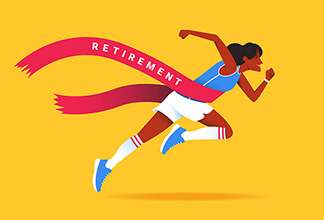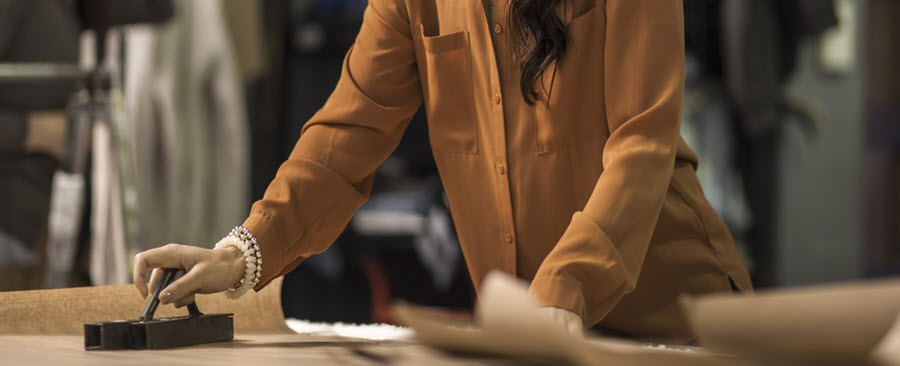Linking the Lingo of Fashion and Finance
Written by Rita Silvan
Published on April 27, 2017
minute read
Share:
Seeking an escape from 18-hour days of spreadsheets, a growing number of Wall Street analysts are changing course and starting their own fashion brands.
"If you spend a lot of time in finance, you eventually want something radically different," the co-founder of personal shopping and styling startup Quinn — and a former Wall Street-er — recently told fashion publication Glossy.
While fashion and finance may seem worlds apart, there's surprising symmetry in the language. Perhaps the jump from finance to fashion isn't such a stretch after all. Here's a breakdown of common lingo:
Bias: Cutting fabric in a diagonal direction, or along the bias, gives it more stretch so it drapes over the body in soft folds. Bias in financing is a little less cut and dry. A bias can be a cognitive or emotional predisposition that interferes with rational decision-making. It can also refer to an investment style like "home bias," for example, as in the tendency to invest more heavily in domestic markets.
Cap: While you may don one on your head from time to time, in the world of finance, cap is more commonly known as the abbreviated form of "capitalization," or the market value of a company's outstanding shares. That company you're interested in has 160 million shares outstanding and it's trading at $10.50 per share? Market cap = $1.68 billion. Generally, companies with market caps of less than $2 billion are considered small caps, those between $2 billion and $10 billion are typically considered mid caps, and large caps are often considered to have market caps of $10 billion and above. Why care about market cap? For one, it's a gauge on how big or small a company is, which can be important when you're trying to compare it to other companies in the same industry. It can also help you evaluate which companies may have more room to grow.
Derivatives: As the saying goes, "Imitation is the sincerest form of flattery." Well, that's not always the case when it comes to fashion. When designers are criticized for being too derivative, they're being criticized for copying another designer's work. In finance, a derivative is a contract between parties whose value is derived from another underlying asset, such as stocks, bonds, or currencies, for example. A stock option is a type of derivative, giving the buyer the option to buy or sell a stock at a certain price until a certain date.
Face: The face of a fabric is considered the "right" side, or the side that's meant to be seen. In finance, tack on the word "value" to make it face value, and it's the amount at which securities are issued, or the nominal — or dollar — value of a bond, or its par value. For stocks, it's the original cost shown at the time of issue.
Investment: An investment piece on the fashion side often equates to an expensive item, like an Hermes handbag or Chanel jacket, which can retain its cachet and financial value. In finance, any asset you put your money into with the goal of seeing it increase in value would pretty much cover it.
Window Dressing: That would be the art of designing shop windows to entice shoppers and passersby. On the finance-side, it's the frowned-upon practice by some mutual-fund managers trying to improve the appearance of performance just before client presentations by selling losing positions and purchasing stocks with positive momentum.
Style Drift: Ever see a fashion designer take a collection in a completely unanticipated and out-of-character direction? For example, Marc Jacobs' "grunge" collection for Perry Ellis, after which he was let go. In finance, it applies when an investment style drifts from its stated position, either deliberately or due to changes in the profiles of its holdings.
Shift: On the runway, that would be a classic, loose-fitting dress with straight lines that hangs from the shoulder. In financial markets it's a little different, since a shift can refer to a change in market sentiment, from bullish to bearish, for example.
Staple: When it comes to wardrobes, a core component is often called a staple, such as a little black dress, favourite blazer or those go-to pair of jeans. With investing, the consumer-staples sector covers many of the products we use each day — household items, food, drinks, etc.
Does the world of fashion pique your interest when it comes to investing? Stock screeners offers a number of criteria that can help narrow your search for companies in the fashion universe.
RBC Direct Investing Inc. and Royal Bank of Canada are separate corporate entities which are affiliated. RBC Direct Investing Inc. is a wholly owned subsidiary of Royal Bank of Canada and is a Member of the Investment Industry Regulatory Organization of Canada and the Canadian Investor Protection Fund. Royal Bank of Canada and certain of its issuers are related to RBC Direct Investing Inc. RBC Direct Investing Inc. does not provide investment advice or recommendations regarding the purchase or sale of any securities. Investors are responsible for their own investment decisions. RBC Direct Investing is a business name used by RBC Direct Investing Inc. ® / ™ Trademark(s) of Royal Bank of Canada. RBC and Royal Bank are registered trademarks of Royal Bank of Canada. Used under licence. © Royal Bank of Canada 2017. All rights reserved.
The views and opinions in this publication are for your general interest and do not necessarily reflect the views and opinions of RBC Direct Investing.
Explore More

Should I Invest or Pay Down My Mortgage?
Consider these four questions
minute read

As Many Head Back to the Office, Where Could Investors See Changes?
How returning to in-person work could affect a range of investments
minute read

Considering the FIRE Lifestyle? Here’s What Your Investments Might Look Like
We asked three people how they created financial independence and retired early
minute read
Inspired Investor brings you personal stories, timely information and expert insights to empower your investment decisions. Visit About Us to find out more.







